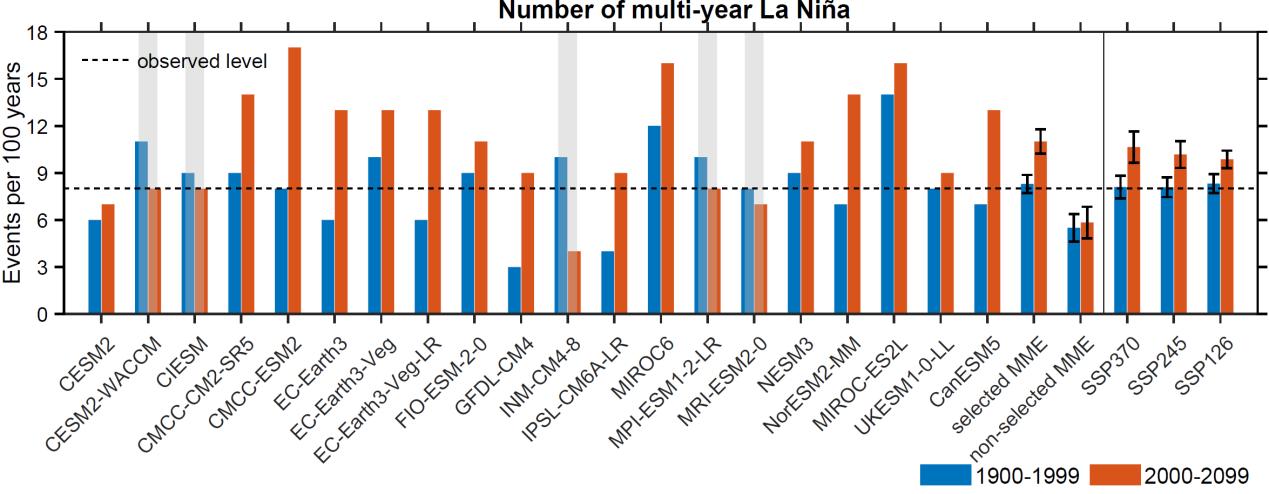Study Discovers How Greenhouse Warming Affects Multi-year La Nina Events
Unlike El Nino that usually last for one year, La Nina tends to develop after an El Nino and last for two consecutive years or more, referred to as multi-year La Nina events. Such events exert prolonged and aggregated impacts as we witness in the 2020-2022 multi-year La Nina.
Determining how the multi-year La Nina events may respond to greenhouse warming has been one of the most important issues in climate science, but it remains unclear.
Recently, Dr. JIA Fan from the Institute of Oceanology of the Chinese Academy of Sciences (IOCAS) and his co-workers have made remarkable progress in understanding how greenhouse warming might affect multi-year La Nina.
The study was published in Nature on July 27.
Based on multiple climate models collected by the Coupled Model Intercomparison Project Phase 6 (CMIP6), the researchers reported a significant increase in the frequency of multi-year La Nina ranging from 19 ± 11% in a low greenhouse gas emission scenario to 33 ± 13% in a high emission scenario, underpinned by a strong inter-model consensus.
Mechanisms underlying this projected increase were then revealed in detail. Under present-day climate, a strong El Nino in boreal winter induces a negative North Pacific Meridional Mode (NPMM)-like response in the subtropical North Pacific, producing a La Nina in the ensuing winter with meridionally broad sea surface temperature (SST) and easterly wind anomalies. Such meridionally broad patterns correspond to a weak negative wind stress curl at off-tropics, resulting in a slow recharge of the upper ocean, which is conducive to persistence of the first year La Nina condition into the second year.
Under greenhouse warming, El Nino is generally more efficient in triggering multi-year La Nina via more efficient tropical-subtropical interaction, which essentially results from a Pacific mean-state warming pattern. Compared with that in the twentieth century, a faster warming in the subtropical northeastern Pacific induces a further northern and more sensitive NPMM-like response to El Nino convective anomalies, which are per se intensified by a faster warming in the equatorial eastern Pacific. The northward-broadened easterlies cause a further slower heat recharge of the equatorial Pacific, leaving a colder upper-ocean condition that is much easier for the cold SST anomalies to persist through the decaying of the first-year La Nina. Therefore, more multi-year-long La Nina events are expected to occur.
"These findings suggest that weather extremes as seen during 2020-2022 La Nina probably occur more frequently in the near future," said Dr. GENG Tao, first author of the study.
"Recent findings indicate a one-way enhancement of the NPMM's influence on El Nino-Southern Oscillation under greenhouse warming. Our discovery of a stronger tropical-subtropical two-way interaction here represents an advance beyond that," said Dr. JIA Fan, corresponding author of the study. "Our results also strengthen calls for an urgent need to reduce greenhouse-gas emissions to alleviate the adverse impacts of increased multi-year La Nina."

Fig. 1 Projected increase in frequency of multi-year La Nina events under future greenhouse-gas forcing.

Fig. 2 The joint impact from the two mean-state warming maxima under greenhouse warming (a) is a northward-broadened NPMM-like pattern that is more sensitive to El Nino warm anomalies (b) in the twenty-first century.
Tao Geng, Fan Jia*, Wenju Cai*, Lixin Wu, Bolan Gan, Zhao Jing, Shujun Li and Michael J. McPhaden. (2023). Increased occurrences of consecutive La Nina events under global warming. Nature.
(Text by JIA Fan)
Media Contact:
ZHANG Yiyi
Institute of Oceanology
E-mail: zhangyiyi@qdio.ac.cn
(Editor: ZHANG Yiyi)